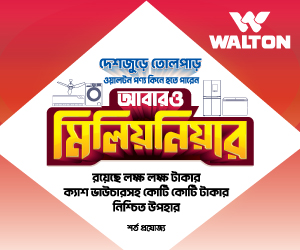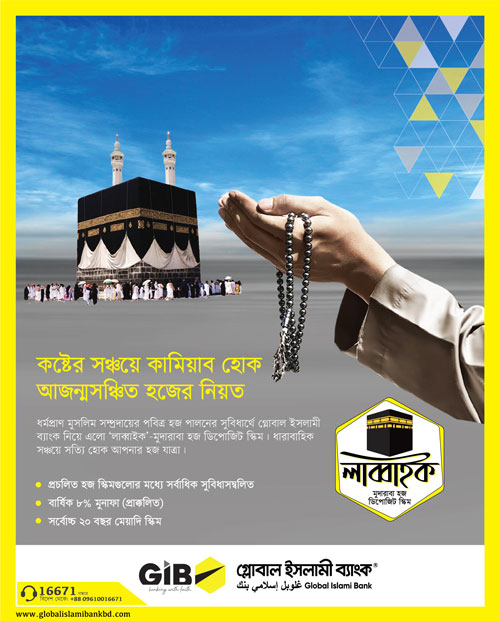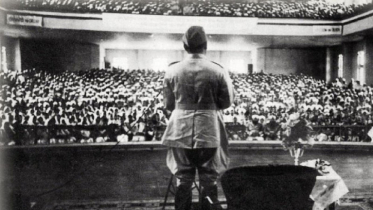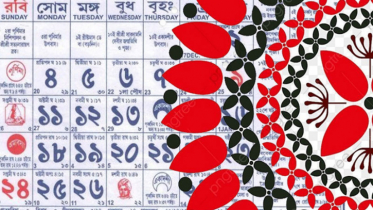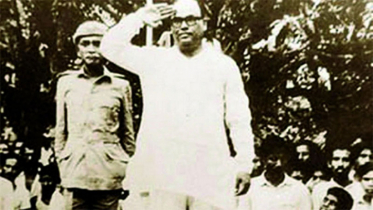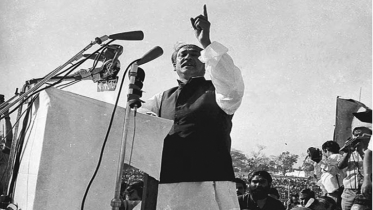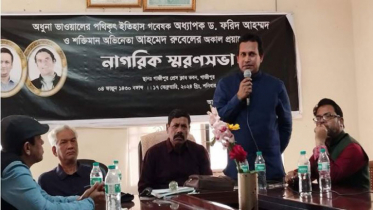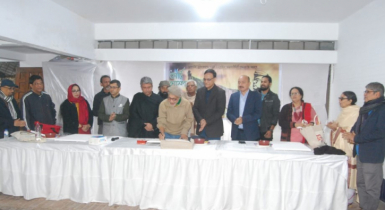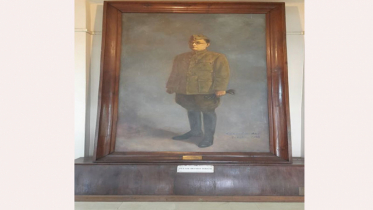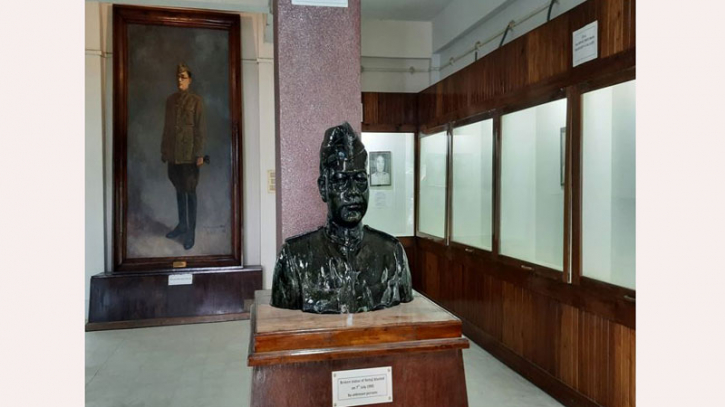
Photo: Writer
STUDY CONDUCTED BY: Boddhisatya Tarafdar; Published By: International Center for Netaji Subhas Ideology (ICNSI), Dhaka
Abstract
The INA or the Indian National Army under the leadership of Netaji Subhas Chandra Bose fought against the colonial British for liberating India and more than fifty percent of the total men of the INA had scarified their lives fighting the British. The INA fought battles alongside the Imperial Japanese forces against the British-American forces for India’s liberation. The Indian nationalist leader Netaji Subhas Chandra Bose’s arrival in Southeast Asia was an important event in the history of Indian Freedom Struggle. However, this brief study tries to examine how Netaji’s presence, the revitalisation of the Indian National Army influenced the lives of the Indians living in the Southeast Asian countries. The personality of Netaji Bose not only impressed the Japanese top government officials but also the Indians of Southeast Asia. The Indians of Southeast Asia contributed hugely towards the war effort of the INA to liberate their beloved motherland, India.
Interestingly, not only the men but Indian women also came forward and formed the Rani of Jhansi Regiment to fight the Colonial British to liberate India. Battles were fought in Burma and in North-eastern part of India, known as the battle of Kohima and Imphal. The war fought in the north-eastern is regarded as the last decisive one of WW II. The participation of the local people in the war to support the INA was significant and it is also important to note that significant political and social changes occurred after the war not only in the north-eastern part of India or Manipur in particular but in entire India. This study lacks the features of a detailed research however, it tries to analyse the war situation in north-eastern India and the impact of Netaji’s military or political activities on the social and political situation in the north-east, as well as in rest of India.
Research Methodology
Type of research used in this study are mainly Research Literature methods, as various books, websites, published research papers are consulted.However, the primary methods of data collection such as, personal interviews of historians and experts were also used. This study report lacks the features of a detailed research work however, it tries to examine a few important points which are of great significance.
Introduction
In 1956 when the former British Prime Minister Clement Attlee was on a two-day visit in India, he stayed at the Governor House in Kolkata. The then Chief Justice of the Calcutta High Court Justice P.B Chakraborty, who was also the acting Governor for the state of West Bengal at that point of time, had some detailed discussions with the British Prime Minister on various issues. Justice Chakraborty later wrote a letter to the publisher of the eminent historian R.C Majumder’sbook “A History of Bengal”. In this letter he stated that “My direct question to Attlee was that since Gandhi’s Quit India Movement had tapered off quite some time ago and in 1947 no such new compelling situation had arisen that would necessitate a hasty British departure, why did they had to leave?” Chakraborty added “In his reply Attlee cited several reasons, the principal among them being the erosion of loyalty to the British crown among the Indian army and Navy personnel as a result of the military activities of Netaji.” This conversation was published by the Institute of Historical Review, in USA by scholar historian Ranjan Borra in 1982.
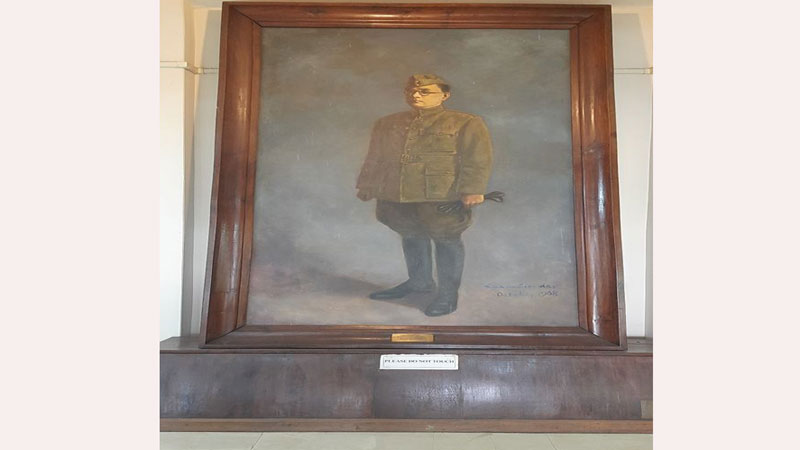
A grand portrait of Netaji at the INA War Museum, Moirang. The museum is a part of the INA Martyrs' Memorial Complex established in 1969. This is presently managed by the Department of Art & Culture, Govt. of Manipur
Background
The aspect of Second World War was a strange chapter in Indian history. The war which continued from 1939 till 1945 had left its deadliest marks on mankind not only in India but in the entire world. India at that time was under the British colonial rule and the whole of Indian subcontinent and its people had no connections at all with the war. But the colonial masters made the Indians fight on their behalf and the Indian men fought bravely at various battle fields of the world and gave their lives at the command of their British masters. The Bengal province witnessed one its worst disasters in the form of the Great Bengal Famine during WW-II. The famine took the lives of around 3 million Bengalis and remained as an infamous example of man-made devastations. British India officially declared war on Nazi Germany in September 1939. The Britishers, as a part of the Allied Force engaged around 2.5 million Indian volunteer force to fight under their command against the Axis Powers.
The Indian soldiers of the British Indian Army fought bravely with distinction throughout the world and more than 87,000 Indian soldiers gave their lives in this devastating war. Importantly, in 1939 the president of the Congress party and the nationalist leader Subhas Chandra Bose after winning the presidential elections for the second time,asked for a nationwide struggle against the British government. He was in favour of taking advantage of the WW-II and throwing the colonial masters out of India with the use of force, which may require foreign help too. Mahatma Gandhi and most of the Congress leaders had different ideas and Bose had to leave the party. Subhas Chandra Bose founded a new political party of his own in 1939 within the Congress, which is the Forward Bloc. It is a matter of great significance that Forward Bloc played a big role during 1939 till 1942 not only in making the people aware about the fact that a nation-wide struggle is required to eradicate the British rule but as a result of its strong campaigning even the Congress had to change its position on the war.
As the Congress initially expressed its support towards Britain, when the war was first declared. However, Subhas Chandra Bose and his newly formed party kept on doing public meetings stating that we must give a six-month ultimatum to Britain to leave India or Indians will go for a national struggle. Due to the strong stand taken by Bose and Forward Bloc, the Congress Party had to change its position and, in its resolution, set a condition for its support that Britain need to declare that India will be granted independence after the war.In 1942, Bose had a great escape from his house arrestand went to Germany and formed the Free India Centreand in 1942 when Mahatma Gandhi announced the Quit India Movement and called for do or die, Bose through his Azad Hind Radio extended his support.
The Bengal Famine of 1943 is the name of another aspect of man-made devastations during the colonial British period or during the World War II which caused the death of nearly 3 million people. People died due to starvation, malnutrition, malaria and due to lack of medical facilities. During the period from 1942 till early 1943, military and political matters combined with the influx from Burma caused huge tress on the overall economy of Bengal which was mainly based on agriculture. Bengal had huge military deployment at that time which had resulted increased food requirements. The government was anticipating a Japanese invasion via eastern border of Bengal and the British destroyed the costal transportation system, so that, the potential invaders did not get access to food supplies, transport and other resources.
Government as according to him there was no shortage of food articles at that point of time. Huge stock of food articles was created to facilitate the war requirements. The required relief could not reach the needy poor of Bengal and the stock was kept to support the war related requirements at various places of the world were British Army was engaged. Importantly, the Viceroy of India Archibald Wavell recommended for stoppage of export of food from Bengal in order to use the same for famine relief. However, the then British Prime Minister Winston Churchill dismissed the request and even went on to state that if the famine was so horrible then why Gandhi had not yet died of starvation. Churchill also refused to accept the free relief materials for Bengal from US and Canada on the point that the requirements are more elsewhere. In this manner Winston Churchill, his government and their selfish colonial policies caused the death of 3-4 million Bengalis and turned Bengal into a graveyard.
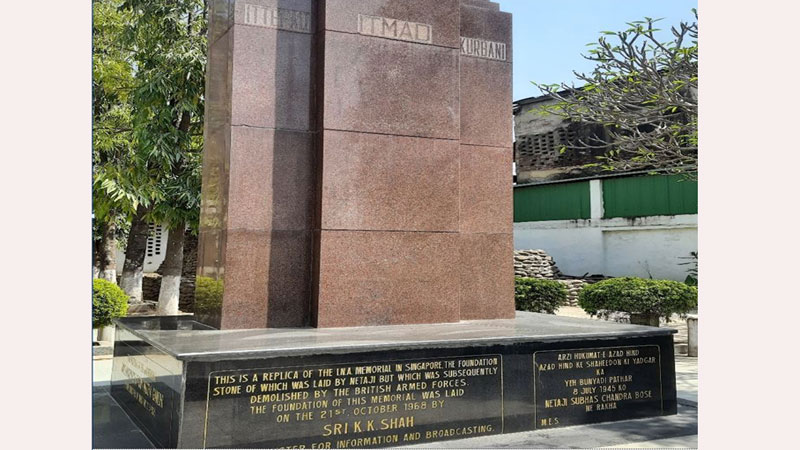
A replica of the INA War Memorial built in Singapore (which was destroyed by the British forces after winning the war) erected in the premises of INA War Museum, Moirang
The making of Netaji
Subhas Chandra Bose is one of the most dynamic leaders of India’s freedom struggle and one of the greatest personalities that India ever had. He was and till today is worshiped by millions of Indians. This immense popularity gave him the title of ‘Netaji’, which means the ‘great leader’ or the ‘beloved leader’. Subhas, a brilliant student appeared in the Indian Civil Services examinations in England to fulfil his father’s aspirations and got the fourth position in the merit list but he did not accept the job. He returned to India and joined the Independence Movement under Mahatma Gandhi. In a very short time Bose became a very popular political figure in Bengal and in India. In 1938 he was elected as the President of the Congress party. Unlike Mahatma Gandhi, Netaji was of the opinion that the colonial British could be eradicated only with the use of a systematic armed revolution, as they denied the independence or autonomy of India after the WW-I. After getting marginalised by the Indian political sphere, he approached the German and the Japanese Govt for assistance to liberate India during the WW-II.
Subhas Chandra Bose Arrives in Tokyo
On June 10, 1943 Netaji met Hideki Tojo, the Japanese Prime Minister. Netaji received a warm welcome from Prime Minister Tojo. Netaji, till that time became a big name not only in the political sphere of Japan but in entire East Asia. He was not only the former President of the Indian National Congress but a person of great courage and political will who had already impressed the Italians and the Nazi Germans. The German foreign minister himself got highly influenced by Netaji’s persona and helped him to form the Free India Centre and even arranged a meeting with Hitler. Prime Minister Tojo was also very much impressed by the magnanimous personality of Netaji and assured him to provide all kinds of assistance for India’s independence. On June 12, 1943 Tokyo Radio announced the presence of Netaji in Japan.
Prime Minister Tojo declared about Japan’s commitment to help Subhas Bose to achieve India’s freedom in the Japanese legislature. Netaji then held a series of meetings with the Japanese top officials and briefed the press about the overall future activities. He extended his support to the Quit India Movement declared by the Congress in India and mentioned the press that the same needed to be escalated as an armed struggle. He stated “only when the Indian people have received their baptism by fire on a large scale, will they be qualified to achieve freedom.”Netaji then addressed the people of Indian origin in Japan, Singapore, Malaya and of the entire South East Asia to get ready to begin a mammoth fight against the British for the sake of independence of India.
The beginning of the Singapore Epic
“Chalo Dilli”
On June 27, 1943 Netaji arrived in Singapore and he was accompanied by Rash Behari Bose. Netaji was welcomed like a hero by the members of the INA and the Indian diaspora who were eagerly waiting for his arrival for months. Thousands of people gathered just to get a glimpse of the great man and he was like a Messiah for them. People shouted slogans ‘Netaji SubhasChndra Bose ki jai’ and the INA band sang the famous song composed by them ‘Subhasji, Subhasji wojane Hind aagaye’. On July 4, 1943 at the Cathey Cinema Hall which was then the tallest building in Singapore, a meeting was organized, which was attended bythe INA officials and thousands of Indians from various places of South East Asia. During that meeting Rash Behari Bose formally introduced Netaji and stated that “I have brought for you one of the best specimen of an Indian, Subhas Chandra Bose” and he officially handed over the charge of both Indian Independence League and the Indian National Army to Netaji. And, then Netaji addressed, he said that the road to freedom would be full of pain and troubles but it was certain that India shall be free. Now the INA men were sure that they had got the true leader who was fearless, person of great stature, high repute and having the will to lead them to the freedom of India. On the next day at the Singapore City Hall ground Netaji reviewed the march past by the 1500 INA soldiers led by the INA military chief Maj. Gen. Kiani. The Japanese Prime Minister Tojo was present in the event as the Guest of Honour.
The famous slogan of “Chalo Dilli” or onwards to Delhi was given by Netaji during his address and he said the historic Red Fort of Delhi would be their final destination, which became the war cry of the INA. After that Netaji addressed many gatherings at various places of South East Asia. He travelled to Rangoon, Penag, Bangkok and Saigon and received great receptions by the Indians. Netaji emphasized that INA should be a true Indian force and common Indians of South East Asia must join. He decided not to be fully dependent upon the Japanese help and he started raising funds for the INA from the people of Indian origin. The famous slogan of Netaji“Give me blood and I shall give you freedom” changed the lives of many Indians who not even for once visited India and now they were ready to donate everything they have for the cause of the freedom of their motherland ‘India’. Thousands of Indians also joined the INA and got trained to fight the colonial British. Netaji urged the Indian women to join the INA and they should not refrain from fighting the enemy. The Japanese army officials initially made some objections to this but those could not stand in front of Netaji’s decision. Netaji decided to create an all-women regiment in the name of the great warrior Queen of Jhansi ‘Lakshmi Bai’ who sacrificed her life fighting the British during the 1857 uprising in India. Capt. (Dr.) Lakshmi Swaminathan of the INA was given the responsibility to form the regiment. Netaji also decided that the expenditure to be incurred for the women’s regiment would be taken care by the funds raised by the INA and Japanese help would not be taken. This was probably for the first time in the history of warfare in the entire world that an all-women regiment was made and they were trained to truly fight on the battle field.
Formation of the Provisional Government of Free India in Singapore
On the historic day of October 21, 1942 Netaji proclaimed the Arzi Hukumat E Azad Hind or the Provisional Government of Free India in exile (this was a provisional govt. as a permanent Indian government could only be established by the people of India when India becomes independent). Netaji took the oath in front of a huge gathering in Singapore as the Prime Minister and Head of the State. As Netaji took the oath “In the name of God, I take this sacred oath to liberate India and four hundred million of my countrymen” his voice chocked out of emotion but he continued “I, Subhas Chandra Bose, will continue the sacred war of freedom till the last breath of my life”. This was a red-letter day in the history of India and especially in the history of Indian freedom struggle. The government created their own civic code, it had issued postage stamps and it also established a bank known as ‘Azad Hind Bank’, which also issued currency notes. ‘Hindustani’ was adopted as the official language by the provisional government. The simplified Hindustani version of the song Jana Gana Mana by Rabindranath Tagore which is Shubh Sukh Chain was adopted as the national anthem. The government was recognized by Japan, Germany, Italy and other axis power nations. Netaji received a congratulatory note from Ireland.
Though the Soviet officially did not make any announcements to recognize the Azad Hind Govt. however, the Azad Hind govt. had a consulate office in the Soviet and by studying the declassified documents this may be easily understood that Netaji maintained cordial relationship with the Soviet Union. Prime Minister Tojo gave the territorial authority of the Japanese captured Indian territories of Andaman and Nicobar islands to Netaji Subhas Chandra Bose. October 23, 1943 the provisional government of Azad Hind declared war on Britain and America at five minutes past mid night. The war of independence had Singapore was roaring with the slogans of Jai Hind and Chalo Dilli and all the Indians were charged up for a massive fight. As per the official history of the INA the total strength of the INA was 60,000. The Supreme Commander of the INA, NetajiSubhas Chandra Bose decided to launch the war through the Indo-Burma border and that is why, he shifted his head quarters from Singapore to Rangoon. Netaji was very clear about the role of the INA and before beginning of the INA advance, he made a final deal with the Japanese authorities that they would have no authority over the INA and the INA would have full control over the areas of India which would be captured by the INA. Only Indian tricolor would be hoisted in those areas and the Japanese force’s role would be restricted to help the INA after entering into India.
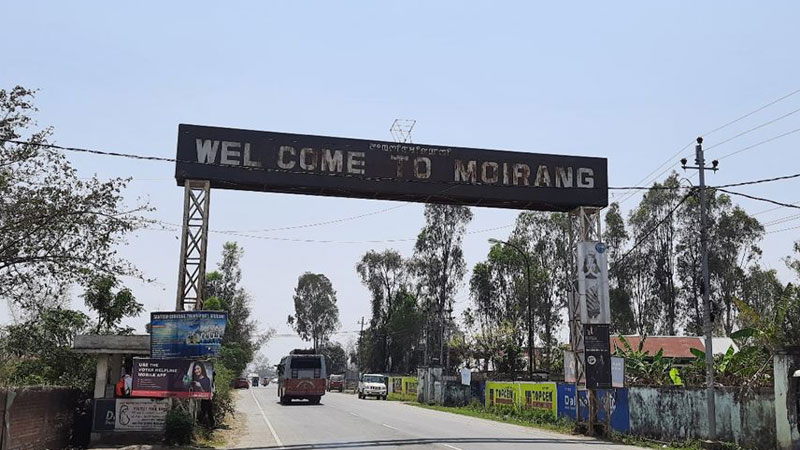
The road from Imphal entering Moirang, April 2021
The war of independence by INA
Until January 1944, the Japanese authorities could not take the decision to launch an offensive in Burma. Their commander in Northern Burma, General Mutaguchi was convinced with the idea that firstly the British forces need to be defeated in Arakan, involving all their reserves in the battle for Chittagong or Chattogram and the gateway to eastern Bengal. Then in April, Imphal and Kohima could be captured, without the danger of the British forces being reinforced. The plans were to be approved from Tokyo and Mutaguschi received the orders in February 1944. The Indian National Army or the INA under NetajiSubhas Chandra Bose was about to assist the offensive in two ways. One, to be espionage and propaganda group with each Japanese division and secondly, an independent role for the Subhas Brigade, which was left to Netaji to decide after having discussion with the Japanese authorities.
On the other hand, Netaji arrived with his key ministers of his cabinet in Rangoon in January 1944 to discuss matters related to the attack to India with the Japanese Commander -In- Chief, General Kawabe. As the Subhas Brigade had already started its preparations to move forward, therefore, Bose was firm and clear in his opinion that the INA brigade must maintain its identity and will spearhead the advance into Indian soil. Netaji had an immediate vision that he would increase the number of his soldiers, which he would raise from new Indian prisoners of war, he could see the tricolour flying at Kohima and Imphal, on the banks of river Brhamaputra and the people of India welcoming him, in days to come. However, the Japanese Commander-In-Chief was not very confident about the abilities of the Subhas Brigade, which was till then untested. In the month of January Netaji accepted two trial roles for Subhas Brigade, the first battalion was for form part of the KaladanVelley and the other two battalions were to relieve a Japanese battalion in guarding the Chin Hills.The offensive was launched in Arakan in February 1944 and the INA men played a big role in a great Japanese victory in the Arakan Hills. INA commander Major L.S Misra’s men were appreciated for role in the offensive. Netaji was getting prepared for establishment of civil government, after capturing the Indian territories.
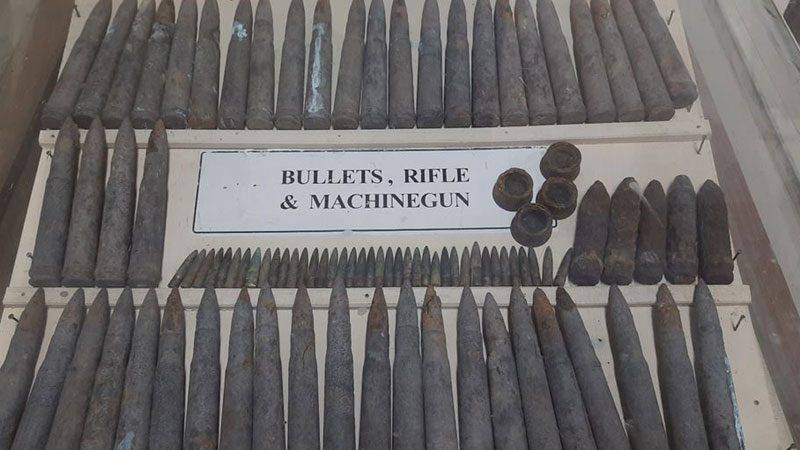
War artefacts displayed at the INA War Museum, Moirang
Col. A.C Chatterjee was given the responsibility to establish the civil governments and then the appointment of Governors, setting up the Azad Hind Bank branches, printing of currency notes to handle the financial matters, etc. all these aspects were planned and properly drafted. On April 7, 1944, the Imphal campaign was launched and Netaji took a small headquarters in a small hill town of Maymyo near Mandalay. The fall of Imphal was expected within next three weeks. The Japanese troops and the INA irregulars entered the Indian territory on March 19, 1944 and just after two days, Japanese Prime Minister H.Tojo announced in the Diet that the Azad Hind government would administer the captured Indian territories. Netaji immediately issued a call to the Indian people to cooperate with the Japanese-INA forces. The Bahadur Group, a special unit of the Col. Shaukat Ali Malik, which was moving with the Japanese 31 division, captured the important township of Moirang in Manipur and planted the tricolour at that place. That was the first occasion when the tricolour was hoisted for the first time at a strategically important location after entering India. The INA established a small headquarter and a civil government to govern Moirang and the surrounding areas, with the support of the local Manipuri people. Then on April 21, 1944, NetajiSubhas Chandra Bose declared about capturing of Kohima by the Indo-Japanese forces.
As the war situation quickly changed, the Anlo-American forces got sufficient time to regroup, they also had a very strong air power. Moreover, the monsoon played the devastating role, which made transportation, reinforcements nearly impossible. General Mutaguchi had to admit that wining Imphal would not be easy as he thought. Col. M.Z Kiani, the divisional commander of the INA wrote from his headquarters, thirty-five miles away from Imphal that the Subhas Bridged commanded by Shah Nawaz Khan must join him. Then Khan informed about the difficulties that he was facing in the Chin Hills, about the scarcity of rations, medicines etc. When Netaji enquired about these issues with Mutaguchi, he accepted these issues but also assured Netaji that very soon Subhas Bridged would join Kiani on the Imphal front. On May 1944, Netaji returned to Rangoon, as the communication facilities were good, so that, he would be able to get the news from the front and also would be able to fly to Imphal easily, whenever, there is a need.But the things were getting worse day by day, as the Japanese-INA soldiers were not getting transportation, supplies due to the heavy rainfall, on the other hand, the British-American forces could get the reinforcements with the help of railways and air support. The INA braves were dyingout of starvation and malaria, the situation was horrible. The Japanese-INA forces faced huge casualties in the war and the Japanese-INA forces had to retreat. Then they also lost Burma from their control after a devastating war with the British-American forces. Finally, America dropped two atom bombs in Hiroshima and Nagasaki cities of Japan and then Japan surrendered to the allied forces on August 15, 1945. Importantly, Netaji and his INA or the Government of Free India did not surrender. Netaji disbanded INA, only to regroup to continue his fight for India’s liberation. He had plans to go to the Soviet to seek help, however, as per the official reports Netaji’s plane crashed in Taipei and he died. But there are no specific evidences of his death. Later, various committees and commissions were setup in independent India to investigate the matter of Netaji’s death or disappearance, however, there is no conclusion to the death mystery of NetajiSubhas Chandra Bose yet. In this way journey of the Indian National Army ended.
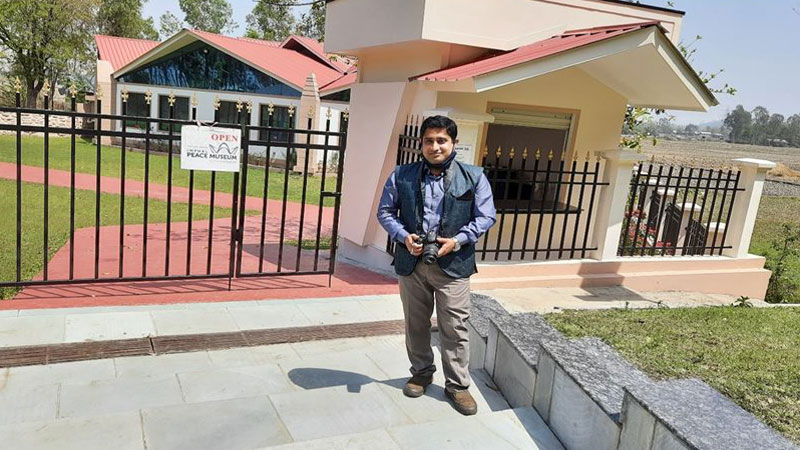
The road from Imphal entering Moirang, April 2021
INA movement &North-eastern India, particularly Manipur
The Japanese forces began to enter inside the territory of Manipur from three different directions. During this time, the British government carried on a series of psychological warfare to win over the mind of the people of Manipur by distributing leaflets from the plane. Their main concern was to stop the possible moral and physical support of the people of Manipur in favour of INA. At that time the political condition in Manipur was also in a very fluid situation. The idea of the growth of political consciousness was very strong and the demand for the establishment of a responsible government in Manipur was very high. That is, the idea of anti-colonialism and anti-feudal feeling was very in the mind of the people of Manipur. The INA also distributed pamphlets to the people of Manipur and seek the support from them. It is said that some of these pamphlets were brought by two tribal people from Sugnu, a remote place in the southern side of the valley of Manipur. The message of Netaji appealed to the people of Manipur, especially the leaders and workers of the Indian National Congress to extend unstinted support to the INA- Japanese forces. The leaders and workers of the Nikhil Manipuri Mahasabha which also had similar ideas and objective with India national Congress, welcomed Netaji’s the appeal.
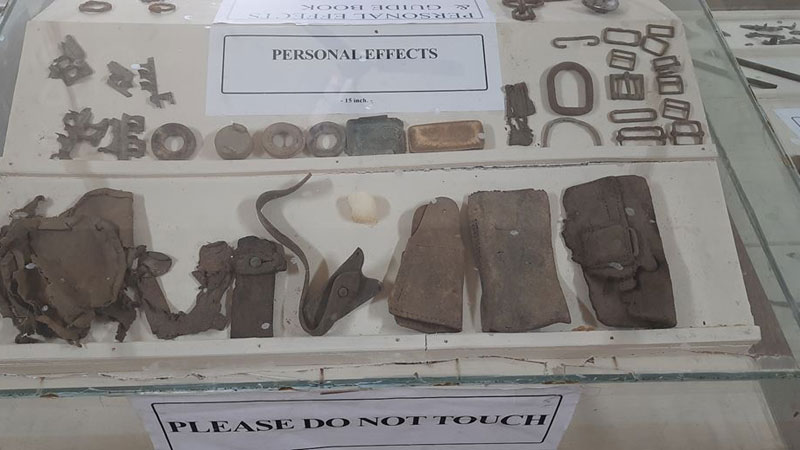
War artefacts displayed at the INA War Museum, Moirang
Initially, there were 32 local Manipuri men who earned their livelihood in Burma joined the movement under the leadership of L. Guno Singh of Khurai, Imphal and they took part in the war. 13 out of 32 Meiteis reached Pallel as advanced party and tried to secure the recruits of the enemy and also to seek the support of the local people. 19 out of them marched towards the Tiddim road and reached Manipur valley and out of them 4 were arrested by the British army at Khuga Valley at Churachandpur, Manipur in the month of March, 1944. A large number of Manipuri Tribals who were the members of the erstwhile British V force also joined the movement and took part in the war. In the morning of April 14, 1944 the leaders of INA-Japanese Advanced Group had a discussion with M. Koireng Singh and some local men at Tronglaobi village. On the same day, Col. Shaukat Ali Malik, Commander of the Bahadur (Intelligence) Group of INA planted the Tri-Colour flag with Springing Tiger embossed on it at the historic MoirangKangla, Manipur. On the next day the leaders and workers of the Nikhil Manipuri Mahasabha welcomed the appeal made by Netaji. 13 members of the Mahasabha from Imphal joined with the members of Moirang and worked together with the people of Moirang and collected large quantity of ration and carried out espionage activities. They all join the INA All the surrounding villages up to Nighthoukhong on the north were liberated from the British yoke. All the southern parts of Manipur from Ningthoukhong onwards were liberated from the British rule and the Provisional Government of Free India controlled the area for three months till July 15, 1944. The INA and Japanese forces were able to get proper and regular food and all other essential things from the people of Manipur. To see this condition, the political agent of Manipur ordered to kill some leader like M. Koireng Singh, L. Sanaba Singh, K. Gopal Singh and H. Nilamani. The 13 members of the Nikhil Manipuri Mahasabha were blacklisted by the government. A number of Manipuris joined the INA and contributed to the last fight for freedom from the British yoke. During the INA and Japanese forces stay in different parts of Manipur, the local people supported them in many ways.
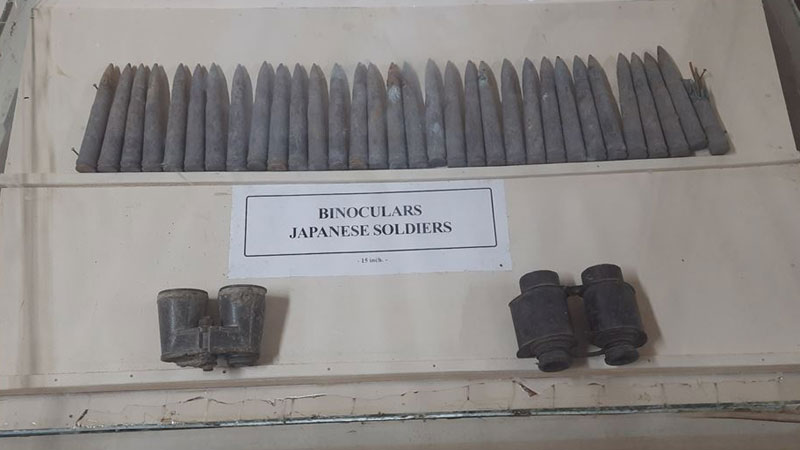
War artefacts displayed at the INA War Museum, Moirang
By the end of June 1944 both the Japanese and British forces fought a severe battle with very heavy casualty on both sides. The British concerned was to break the ring round Kohima and achieve a link up with beleaguered Imphal. The Japanese efforts on the other hand were directed to capture Imphal and its supply dumps before being driven off from Kohima and road blocks that had been put up between that place and Imphal. The INA and Japanese troops based in Moirang were fighting very hard in and around Bishenpur with the British forces. The British could bring more troops as reinforcement by rail and road up to Kohima from Assam and keep them regularly supply; their IV Corps fighting in the Imphal plain was being reinforced and maintained through virtually uninterrupted air operations. The 5th and 7th Divisions which made a decisive difference to the fighting around Imphal had been air lifted from the Arakan – a development which the Japanese had originally not taken into account. Because of uneven contest, the INA and Japanese forces fighting in Beshenpur and around Imphal but could not capture Imphal.By that time, a very heavy downpour started in the north-eastern India and Chin hills. As per M.Z. Kiani, the supply problem in fact had become so grave that why the third week of June, the INA were hoping that Imphal would not fall but that we all withdraw in time to the line of the Chindwin River, where supplies could be brought up. The fair was that available supplies in Imphal would not meet the requirements of all the Japanese and INA forces as well as the trapped IV British corps and that innumerable soldier would starve to death. With the fall of Imphal further British supplies would naturally have ceased while the Japanese would not have been able to bring in any while the monsoon lasted, and there were still at least three months of the rainy season to go. The Japanese attack on Imphal without a doubt came within ace of success. However, there were many important factors operating against them in the beginning of 1944 when they started large scale operations, first in Arakans and then in of Manipur. Finally, they were withdrawn from Manipur and retreated fully.
Importantly, Dr.Vekho Swuro, who is an expert on Netaji and INA matters and an intellectual from Nagaland, stated about Netaji and INA’s presence in Ruzazho village during April- May in 1944, in today’s Nagaland, which was then the Naga Hills district of Assam. As per the oral testimonials, Netaji along with his INA men stayed there for nine days and appointed ShriPuswuyiSwuro as the interpreter and the representative of the INA. The local villagers supported Netaji and INA’s mission. It is also said that Ruzazho village was the first administered village in India under the INA.
Impact on the Socio-political situation of Manipur
It is important to note that, the INA and World War II had produced a tremendous impact in the future life of the people of Manipur. Manipur was surely one of the main battlefields of the World War II theatre and it affected almost all the normal life of the State. The economic situation of the state totally collapsed, as due to the war the agricultural activities were almost stopped. As a result, the people had to survive of rations, which continued till 1945. The then, Government of India under the British, also decided to give relief measures to villagers whose household articles were either stolen or loss during the war. Relief measures were also taken up for the construction of damaged houses. As many as 5,503 houses in 409 villages were destroyed. The worst affected areas were Moirang (550 houses), Bishenpur (26 houses), East area (2,100 houses in 160 villages), Valley area (1,463 houses in 59 villages), Sadar area (1,636 houses in 163 villages), Mao area (137 houses in 8 village) and West area (209 houses in 19 villages).
However, though the INA could not fulfill its military mission, its political mission was more than achieved. As a result of the military and political activities of the INA, the growth of the idea of political consciousness started to grow. The sense of patriotism among the people of this place was a great achievement of the movement of the India National Army. Even the common people, after having this experience could understand the political trend in Manipur as well as in India. Then it also helped in the strengthening of the relationship between the leaders of Manipur with the other national leaders of India. On the other hand, it also helped to growth of a sense of oneness among the people and idea of nationalism was gradually emerged among the people of Manipur. The establishment of Manipur State Congress Party in the year 1946 was an immediate impact of the movement of the Indian National Army. The objective of the party was to establish a responsible government on the basis of democratic principles. Therefore, the establishment of this party was undoubtedly laid basic foundation for having a close relationship between the All India Congress and the Manipur State Congress. It gave an opportunity to expose to the national and international trends and gave the opportunity to fight for new socio-economic and political changes in the state. The politics of the different parties like the Manipur State Congress, KrishakSabha, PrajaSangha, Kuki National Assembly, NCC and the Mizo Union in the hills may be examined for the background of the movement of Indian National Army. The hill people also awakened and they began to cry of democracy and independence. It is important to note that, in independent India, M. Koireng Singh, a member and one of the biggest supporters of INA became the first Chief Minister of Manipur.
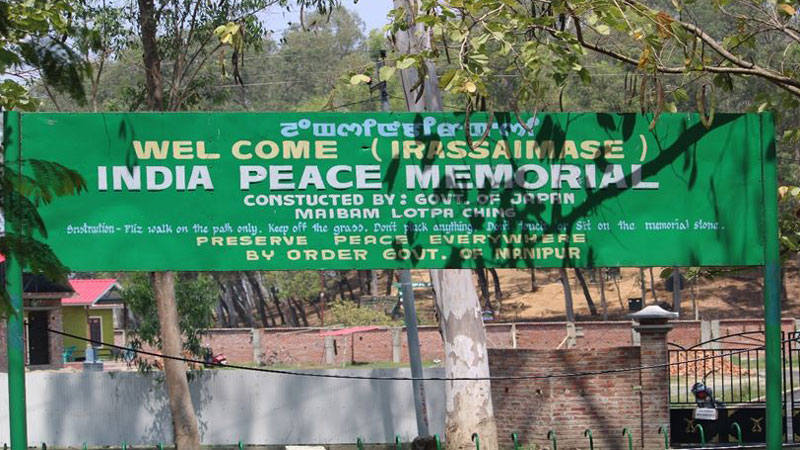
India Peace Memorial, near the Red Hill where the deadliest battle took place during the Imphal campaign, it was constructed by the Govt. of Japan in 1994 in memory of the brave soldiers who lost their lives during the war
The Imphal Peace Museumis a World War II related museum at the foothills of the Red Hills, near Imphal, founded in 2019 on the 75th anniversary of the Battle of Imphal. It is a living memory of the Battle of Imphalfought in Manipur. Other than the war related exhibition, the museum also exhibits the colourful culture of the ethnic people of Manipur. It is supported by the non-profit grant making Nippon Foundation, collaborating with the Tourism Corporation of Manipur and the Government of Manipur. Imphal Peace Museum’s interior and exhibitions designs are one of the best works done by International Award-winning designer Suresh Huidrom. In 2019, the Imphal Peace Museum won India's Best Design Award for the Creativity and Innovative Interior Design. In 2021, the museum represented India at the Muse Design Awards 2021, New York City.
As per the Indians of Southeast Asia & the INA veterans
The Indians living in Southeast Asia were mainly involved in rubber plantation works, business activities and clerical jobs related to the administrative works. The majority of the Indian people were the labourers migrating from South India (to be precise, mainly the Tamil speaking people from the Madras Province of India). The condition of the labour class people in particular was pathetic and they had to work and live in extremely poor conditions. During the WW-II, after the arrival of the Japanese and formation of the IIL, the British in Malaya, Burma and in Singapore, the Dutch in the East Indies, the French in Indo-China and the Americans in Philippines were no longer the masters. Then, to most of the Indians living in the British colonies of Burma, Malaya and in Singapore – the arrival of Subhas Chandra Bose and the revitalisation of the INA and the formation of the Azad Hind Govt. was a matter of immense importance. Joining of INA gave them a great sense of pride and dignity, the people who were so long oppressed and exploited by the colonial powers, now Netaji suddenly transformed them into freedom fighters. The influence of Netaji’s public addresses and his personality was so much that there were many instances where the Indians used to have Netaji’s photographs at their homes along with the pictures of Hindu Gods and Goddesses and their forefathers.
As per the archival records of the National Archives of Singapore, a number of personalities of the Southeast Asia, who were involved with the INA movement or the INA veterans, opined that the impact of Netaji Bose and his INA was of great significance among the Indians living in Southeast Asia. The persons like Mr.Damodaran, AtoshiMunshi, SushilChatterji, NarayanaKaruppiah, Mr.Thivy. K.M Rengarajoo, Girish Kothari, Kishore Bhattacharya, Col. P.K Sahgal, Dr. Lakshmi Swaminathan, JanakiAthiNagappan and others have stated that how Netaji’s speeches were effective in mobilising men, material and money for the INA or for the war of India’s independence. Even the women who were mainly rubber plantation workers joined the INA after Netaji’s appeal. The Japanese top Govt. officials had high regards for Netaji Bose and he made them bound to understand that the INA was their ally. The Japanese officials opposed the formation of the All-Women Regiment but they could do anything in front of Netaji’s high esteem, later, they also asked the INA to fight against the Burmese Liberation Army but Netaji rejected those proposals, these events prove that both Netaji and INA were not the puppets of the Japanese. Netaji established the Azad Hind Schools for the young boys to get trained and he also sent the young men to the Tokyo Military Academy for advanced training but all the expenditures were taken care by the INA funds and Japanese help was not taken. More importantly, Netaji could bring a sense of unity among the Indians of all sections of the society, cut across linguistic, religious, caste and regional differences among the Indians.
INA & liberation of India
In the introduction of this study, we have already mentioned about the statements of the former British Prime Minister Clement Attlee, who very clearly expressed that his government took the decision to grant independence to India due to the agitations, revolts occurred in the British Indian armed forces, as a result of the military activities of Netaji and his INA. We must understand thefact that,NetajiSubhas Chandra Bose’s military and political activities in Southeast Asia and during the Imphal Campaign and the subsequent INA Trials in Delhi erupted great national anger among the masses, particularly in the Indian armed forces. This resulted in mass agitations in major cities and towns across India in support of the INA men. The Indian men of the British forces in India started openly supporting the INA. The INA Trialwas staged by the British to humiliate the struggle of the INA and treated as traitors and media was allowed to cover the proceedings. However, as the court proceedings went on, the INA officials and their defence could successfully establish their position, which led to a serious embarrassment to the British authorities and on the other hand, the people of India became aware of the sacrifices of the INA men to liberate their motherland under the leadership of Netaji. Then, the Royal Indian Navy revolt happened in 1946 and revolts started in the Indian air force and in the army units in Jabalpur. These events shook the foundations of the British government in India.
It is also important to note that during the time of the war the only major movement organised by the Indian National Congress was the Quit India Movement, which started in a grand manner in August 1942.However, with the help of war time policies the British could bulldoze the movement with the use of brutal force and all the leaders of Congress, including Mahatma Gandhi were arrested at the very beginning of the movement and the movement failed. As a prove of its failure, we may site the point that when Gandhiji was released in 1944, he himself said on various occasions that he had no more legal authority to carry on with the Quit Indian Movement and could not ask anyone to continue with the movement. In other words, Mahatma Gandhi himself admitted that by then the movement was over.Eminent historian Dr. R.C Majumder narrated in his writings that there is no basis for the claim that the Civil Disobedience Movement directly led to independence. During the first world war, the Indian revolutionariessought to take advantage of German help in the shape of war materials to free the country by armed revolt, but the attempt did not succeed. Subhas Bose followed the same method and created INA but in spite of having brilliant planning and initial success, he also failed. However, the revelations made during the INA Trials and the reactions that it produced in India made it clear for the British government that it was time for them to leave India. As Britain was already exhausted by the war and it could no longer trust the loyalty Indian army-menfor maintaining their authority in India.
Historian Ranjan Borra narrated the whole matter in his research which includes the facts regarding the letter written by Justice Chakraborty (about his discussions with Attlee), to the publishers of R.C Majumder’s book. And, it actually proves the claims made by historian R.C Majumder on how India achieved its independence, with the statements made by Attlee in 1956. Again, just after independence of India, renowned politician and Chairman of the drafting committee for Indian Constitution DR. B.K Ambedkar in an interview to BBC, clearly stated that he did not know how Mr. Attlee suddenly took the decision to grant independence to India, which no one expected at that time and one day Mr. Attlee would reveal the secret. As per his analysis, the reason for such as decision was the national army made by Subhas Chandra Bose and the British knew that whatever the politicians do in India, they would never be able to change the loyalty of the Indian forces towards the British. As per Ambedkar, that believe shattered to pieces when the Indian forces revolted and the British could understand they would not be able to rule the county anymore and that had led the Labour Party took the decision to leave India. This interview was taken a year before Clement Attlee’s visit to India in 1956 and this again clearly proves the point that why the British had left India in such a hurry.
Many modern-day historians and researches are also of the opinion that British finally took the decision to leave India in 1946, mainly due to the fear of a 1857 kind of a situation and the principal reason was the military and political activities of Netaji and INA and the subsequent INA Trials in Delhi. Eminent historian Dr.Kalyan Kumar De in his book “NetajiSubhash: Liberator of Indian Subcontinent”, did great research in to the de-classified British Transfer of Power achieves. He has uncovered the facts with documentary evidences, which has the communications of the governors of various provinces of India, British Indian Intelligence Bureau, Viceroy of India, Secretary of State for India, British Prime Minister and other key persons during 1945-1946. And, these documents states that it was not the non-violent movement of the Congress but the INA Trials, which had shaken the loyalty of the British Indian armed forces and created a wave of violence all over India, that had forced the British government to panic and take the decision to leave India.

BoddhisatyaTarafdar with Smt. Mrinashree Mairembam, Curator of INA War Museum, Moirang, April 2021
Major Findings of the study
1) NetajiSubhas Chandra Bose successfully united all the Indians among all sections of the society living in Southeast Asia and in North-eastern India, particularly in Manipur in India during WW-II to fight for the freedom of their motherland, India.
2) As a result of Netaji’s speeches and appeal the INA could mobilise huge men, material and funds for the war efforts.
3) Netaji formed the All-Women regiment and women from all sections of the Indians joined to fight for India’s independence. This proves the kind of great impact which Netaji Bose had among the common masses.
4) The INA movement helped greatly in the growth of political consciousness among the people of North-eastern India, particularly in Manipur.
5) Like in Southeast Asia, INA movement also helped to growth of a sense of oneness among the people and the idea of nationalism gradually emerged among the people of Manipur.
6) We have also analysed how Netaji’s military and political actions led to the independence of India, though he militarily lost the war.
In Conclusion
From the above analysis, it may clearly be stated that Netaji Subhas Chandra Bose’s military and political activities and the sacrifices made by his INA men and women to liberate their motherland was unprecedented. Netaji Subhas Chandra Bose successfully united all the people among all sections of the society living in Manipur in India during WW-II to fight for the freedom of their motherland, India, which he successfully did for the Indians living in entire Southeast Asia. This fact played a great role in growing political consciousness and feeling of nationalism among the people of Manipur. Again, during the INA Trials, the whole of India got united and even the loyal Indian men of the British Indian armed forces revolted against their masters. Finally, all these led to the end of British rule in India.
When Netaji Subhas Chandra Bose laid the foundations of the INA War Memorial at the Esplanade, Singapore in memory of the “Unknown Warrior” of the INA in 1945, Netaji said “the future generations of Indians who will be born, not as slaves but as free men, because of your colossal sacrifice, will bless your names and proudly proclaim to the world that you, their forbears, fought and suffered reverses in the battle of Manipur, Assam and Burma. But through temporary failure you paved the way to ultimate success and glory.”



